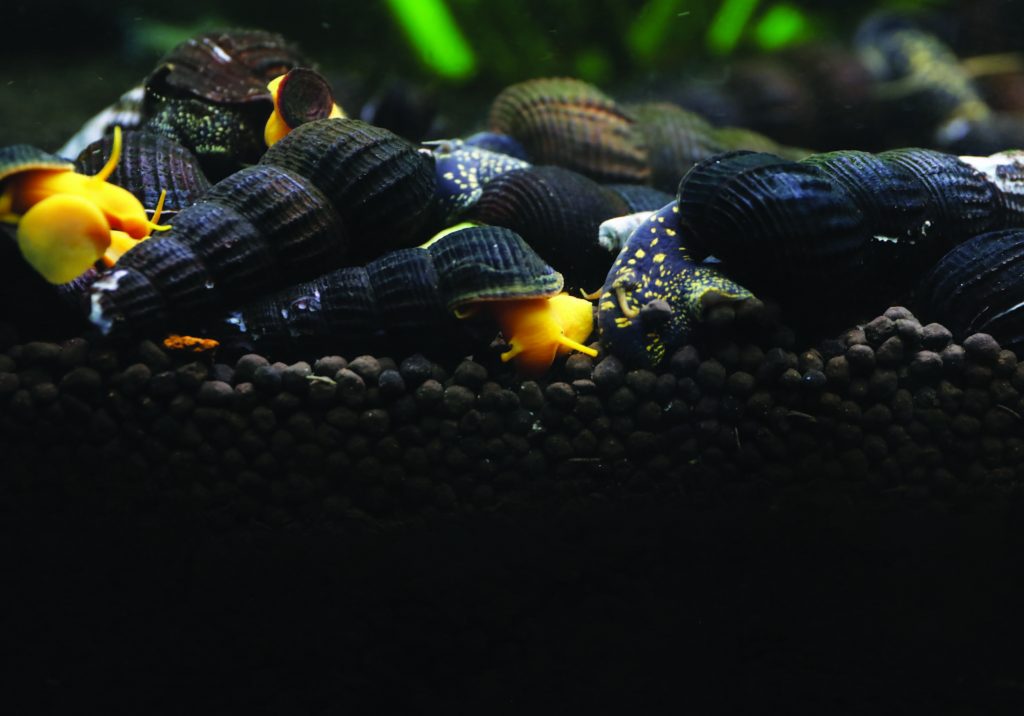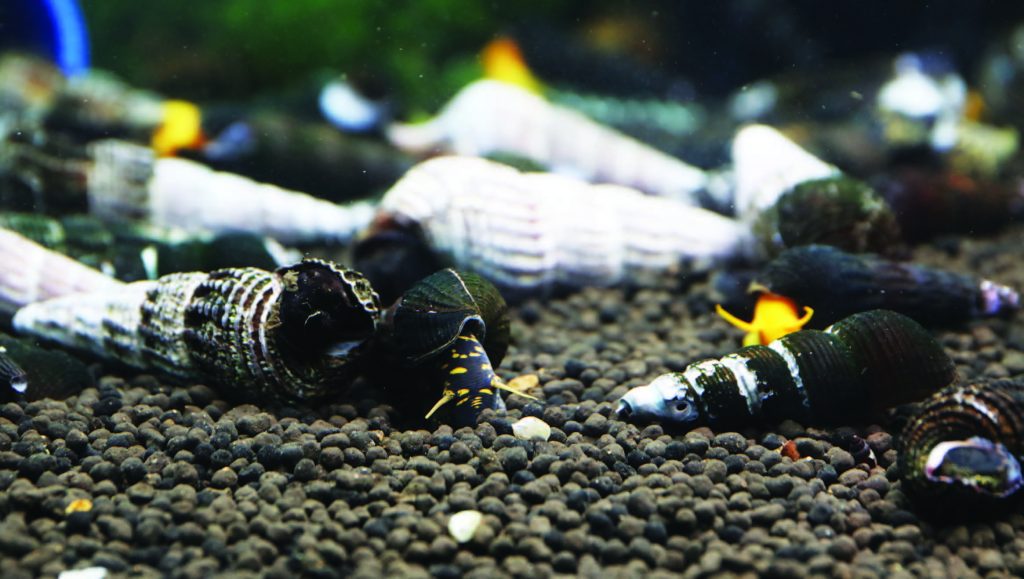Yellow rabbit, yellow elephant
The Yellow Poso Snail, also known as the Yellow Rabbit Snail, hails from the freshwater lakes of Sulawesi, Indonesia. These peaceful creatures are quite active for snails, often found crawling around in both daytime and nighttime.

Rabbit Snails are so-called because they have a long, rabbit-like face, with their droopy antennae resembling the ears of a rabbit. They have expressive faces, ranging from smiling to wistful to even mischievous. “They get quite big,” says Webster Felipe of Pet City. “They also [come in other colors], from bright yellow, orange, black with yellow patches, and light cream green color.”Their shells are medium to large in size and can have many different colors. The shell has an elongated conic structure (unicorn-horn like), with a spire angle of 13-25 degrees. The top whorls in adult specimens are almost always corroded to a varying degree. Their aperture oval is pointed at the top and slightly siphonated at the base.
The size of any individual Rabbit Snail depends on how old they are. Some types can grow up to from 3-4.5 inches (10 – 12 centimeters) in size and are sometimes called Elephant Snails. However, their large size is not the only reason why they are also called Elephant Snails. They have a very long proboscis which reminds us of an elephant’s trunk as well.
Gotta be fresh
Under ideal conditions, Rabbit Snails can live one to three years, or even longer with some luck. While these snails are quite active, it is not totally out of place for them to be immobile for long periods, since that is how they sleep.

Whenever they are resting, their bodies normally curl up inside their shells, with their operculum repositioned to their aperture. So, there is no need to panic if you spot a snail that hasn’t moved in a while.
According to some observations, snails can be awake for 30+ hours with clusters of around seven bouts of sleeping over a 13-15 hour period.
Caring for the yellow poso snail
The areas that these snails inhabit in the wild have a slightly unusual set of water parameters, in that the water is soft, yet alkaline. This can be a little tricky to recreate in the aquarium, and many aquarists opt for keeping them in steady conditions not too far off the natural parameters but in slightly harder, alkaline water.
“We’ve had our first Yellow Poso Snail since October 2018,” says Felipe, “and they live quite long in our tanks. Their vivid color makes them stand out in our aquarium, and they are quite showy once they’ve grown accustomed to their surroundings.”
Felipe uses a special mineral called Dennerle 8.0 to recreate the snail’s natural environment, mixed with distilled water according to directions.
Of much more importance seems to be their temperature requirements; these snails need warm water. The water temperatures in Sulawesi vary slightly from island to island, but never drop below 26 degrees Centigrade even during the wet season, so ensure that these balmy conditions are maintained in the aquarium. In their natural habitat, the pH of the water is around 7.9 – 8.5, and temperatures are constantly above 26 degrees.
“I did not have any idea about caring for this kind of snail before,” says Felipe, “and much of my disappointment stemmed from the wrong water parameters and conditions. I started searching for information and watching YouTube videos for instructions on how to care for them. That’s when I found out that the Dennerle minerals were what had been lacking. Once I started using them, I’ve had success keeping them in our aquariums.”
A pillar of the community
Yellow poso snails are great for peaceful community tanks containing small warm-water species of fish and shrimp, and they will often mate if conditions are to their liking. Avoid keeping them in aquaria that contain loaches, pufferfish, any large or aggressive fish, and any pushy species that will outcompete the snails for food, because these snails cannot survive on leftovers alone.
Felipe says, “These snails are very peaceful and make a great addition to the tank. Set up a ten-gallon tank for three Yellow Poso Snails.”

Ensure the tank is well filtered and oxygenated, and that regular partial water changes are carried out, at the same time carefully siphoning away any mulm (organic debris that builds up in aquariums) that can accumulate from the snail’s waste products. Acclimate them carefully as you would do for fish and you should find that they soon begin exploring their new surroundings.
Some of the snails come from areas with hard substrates and some from softer substrates, so try to provide both options in the aquarium. Sand is much preferred over gravel and is easier to keep clean.
Additionally, some species will munch on soft leaved plants and some won’t, so if in doubt, choose robust greenery. However, be sure to leave large areas free of vegetation so that the snails can move around with ease.
Their unique, jerky fashion of locomotion is fascinating to watch, as they heave their large shells along behind them. These snails do not particularly enjoy bright lighting so be sure to create numerous shady hidey-holes with the arrangement of the décor and diffuse any strong light with floating plants.
The hungry rabbit snail
The Yellow Poso Snail is a good scavenger and a ferocious eater, and they seem very interested in eating some forms of soft algae growing on hard surfaces. Rabbit Snails also seem to like eating decaying plant matter that has fallen to the bottom of the tank.

But their diet should not be limited to the naturally occurring foods in a tank. A Rabbit Snail should also be offered food supplements, especially those rich in calcium. Hobbyists can try things like bottom feeder pellets, algae wafers, and fish flakes for starters. Other food sources can be blanched green leafy vegetables, such as lettuce and spinach, as well as blanched green zucchini.
In general, a well-fed Rabbit Snail should not be interested in eating live aquarium plants. It is said that an exception may be Java Ferns – hobbyists often report that Rabbit Snails are interested in eating them. But other than that, keeping Rabbit Snails well fed on a balanced diet of green leafy supplements, as well as keeping them with plants like Anubias with strong, durable leaves, ensures that plants are relatively safe.
The active snail lifestyle
Rabbit Snail mating occurs in freshwater tanks provided the conditions are right. Fortunately, as with everything else with snails, Yellow Poso Snails mate slowly. A snail produces one offspring at a time, so the tank does not get overrun.
After mating, the snail leaves a small creamy white egg sack behind. The egg sack is about the size of a pencil eraser. Inside the egg sack is a fully formed baby that emerges very hungry. The baby will almost immediately begin scouring the tank for soft algae or other food to eat.One of the nice things to observe about a baby Rabbit Snail is how flawless its shell appears. No pit marks or scuffs, just a well-formed whorl from apex to aperture.
Aquatic enthusiasts do consider Rabbit Snails as easy to deal with. As it is with the majority of freshwater snails, taking care of them begins with a stable, established, and healthy aquarium. “They are unique animals in my experience as a snail keeper,” says Felipe. “They are great companions. They are always on the hunt for food and are active so you will always find that they’re out there somewhere in the tank.”
This appeared in Animal Scene magazine’s November 2019 issue.
You might want to read:
– The many ways of ridding your tanks of snails
– Why pests aren’t pests: A case for the unwanted
– No turning back: 5 animals bidding us a final farewell





